Archived Blog Posts
What are the 3 Categories of Water Damage?
2/13/2023 (Permalink)
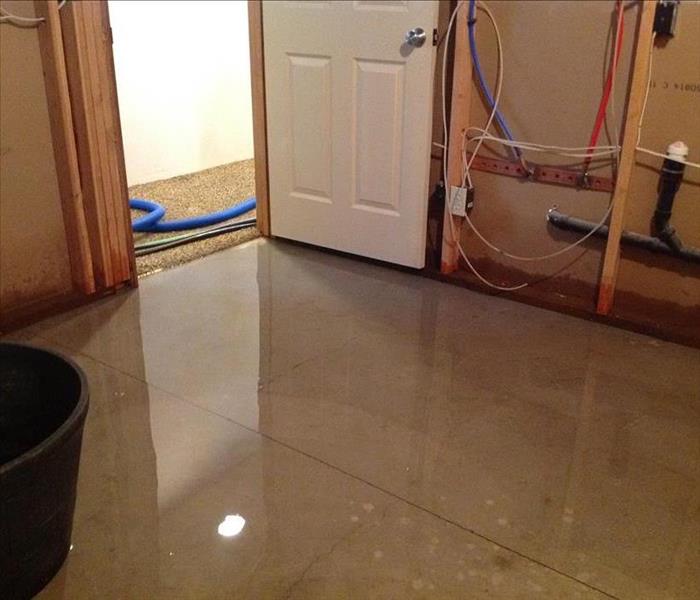 Many people don't know all three categories of water damage that are commonly found in homes and businesses after an unexpected flood or leak happens.
Many people don't know all three categories of water damage that are commonly found in homes and businesses after an unexpected flood or leak happens.
When someone experiences water damage, it can be a significant inconvenience. The clean-up process is often expensive and time-consuming, which can make water damage feel overwhelming. To make matters worse, many people don't know all three categories of water damage that are commonly found in homes and businesses after an unexpected flood or leak happens. However, understanding these categories will help you grasp what you need to do to eliminate the problem before it becomes more serious than it has to be.
There are 3 Categories of Water Damage
There are three categories of water damage:
- Category 1 – This is the least severe type of water damage, known as "clean water."
- Category 2 – The second category is more severe because it involves contaminated water, also known as "grey water."
- Category 3 – This third category is the most severe type of water damage, also known as "black water."
Category 1
Category 1 is the least severe category of water damage. It is also known as "clean water" and can be caused by leaking pipes or supply lines, overflowing bathtubs, sinks, or toilet bowls, and even melting ice, snow, or rainwater.
Category 1 water damage is not necessarily dangerous to your home or belongings, but it should be addressed as soon as possible. If left untreated for too long, Category 1 water damage can cause significant damage to your property and can lead to a mold infestation.
Category 2
Category 2 water damage is also known as "grey water" and comes from water mixed with chemicals or other contamination. It can be the result of broken appliances such as a dishwasher or washing machine, sump pump failures, overflows from toilet bowls, and even condensate water.
Category 2 water can be harmful to humans and pets if they come into contact with it. Because of this, it requires professional decontamination during the mitigation process to ensure that your property is clean and sanitary.
Category 3
Category 3 water damage requires immediate professional attention. This category of water damage is the most severe and can be caused by sewage, floods, or other heavily contaminated water sources. It is also known as "black water."
As contaminated as this kind of water is, you should not even consider attempting to clean it yourself. To keep yourself and others on your property safe, contact a team of experts right away if your home has been affected by category 3 water damage.
Water damage can be devastating. It is important to know what category of water damage you are dealing with after a loss to ensure that your property is getting the proper care. Restoration professionals, such as SERVPRO of Tyler, Lindale, Palestine, are highly trained in all 3 categories of water damage and will take care of your property from start to finish. If you’re dealing with water damage in the Tyler, TX, area and would like more information, don't hesitate and contact our SERVPRO of Tyler, Lindale, Palestine team today!
How to Inspect Your Home After a Storm
1/10/2023 (Permalink)
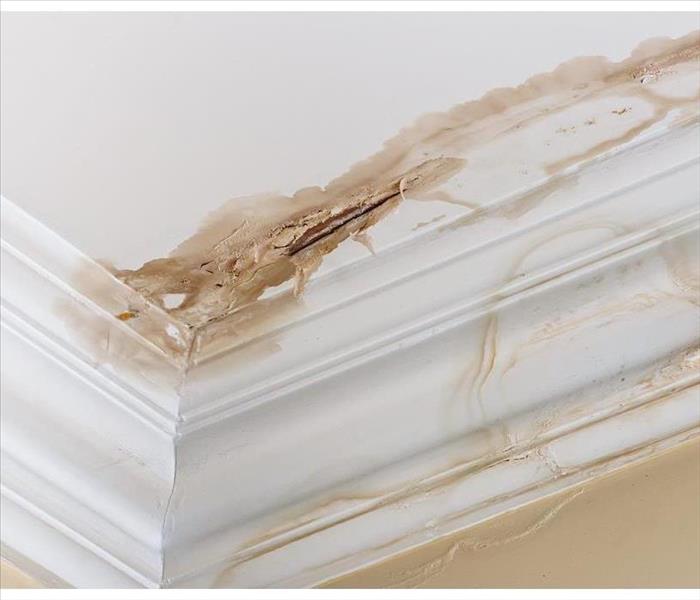 Roof leak found in a home in Tyler, TX.
Roof leak found in a home in Tyler, TX.
A storm is powerful. It can knock over trees, blow out windows and doors, and cause damage to your home. If a storm is coming your way, it's important to prepare for it by securing loose objects outside the house and making sure all household members know where to go during an emergency (the basement or an interior room away from windows). It's also important to inspect your property after the storm has passed. Here are some things you should check in order to make sure your home isn't damaged:
Roof Leaks
After a storm, it's common to find your home has been damaged in some way. A roof leak is one of the most common types of damage and can cause serious problems if left unattended. If you notice any signs of a leak in your roof, take action immediately!
If you notice water stains on the ceiling, it is likely that your attic has a leak. The first step in determining whether this is true, or if the stains are simply due to condensation, is to visually inspect your attic. Look for any signs of damage or leaks such as molding or insulation that may be wet and discolored. If there are no visible signs of leakage, check around the perimeter of your roofline for drips coming from seams in shingles or flashing materials such as metal flashing or roof vents.
Look for damp insulation or interior walls. If you have discovered that there is water coming through the ceiling in one area of your home, it's time to act fast! Many homeowners don't realize how much damage can be done by even small leaks until they've soaked into their walls and insulation for several days or weeks—so if you find any signs that moisture may have gotten into these areas (such as discoloration), call someone who specializes in flood damage extraction immediately.
Damaged Siding and Gutters
Cracks in the siding are are a sign of water damage to the wood framing behind it and should be repaired immediately. A leaky roof or gutter can cause the exterior walls of your home to crack and warp from exposure to moisture. If you find any cracks in your siding, carefully remove any debris that may be blocking them so that they can dry out properly.
Leaking gutters can cause water damage to your home and personal belongings. Make sure to inspect the gutters for any damage, debris, or missing pieces. If you find any of these issues, you will need to replace the gutter system altogether or repair it before heavy rain comes again. Look for leaks at every connection point between your gutters and downspouts to ensure there are no gaps where water can seep into your attic or crawl space below. Make sure all fasteners are secure and tighten loose ones as needed; replace any missing pieces if necessary.
Damaged Windows and Screens
Windows are vulnerable to damage during a storm. If you have any broken windows or cracked glass, look for leaks and cracks around the frame of the window as well.
If your screens have been damaged by flying debris or falling branches, make sure to replace them as soon as possible. Screens that are torn can allow insects and other pests into your home and cause health issues in warmer months if left untreated.
The most important thing you can do to protect your home is to inspect it after every storm. If you notice any damage, get it fixed as soon as possible. Remember that a little bit of work now could save you from costly repairs later on down the line! If you do experience storm damage in your Tyler, TX home, SERVPRO of Tyler is here to help you get back on your feet. Give us a call!
Understanding How Mold Spreads in a House
12/29/2022 (Permalink)
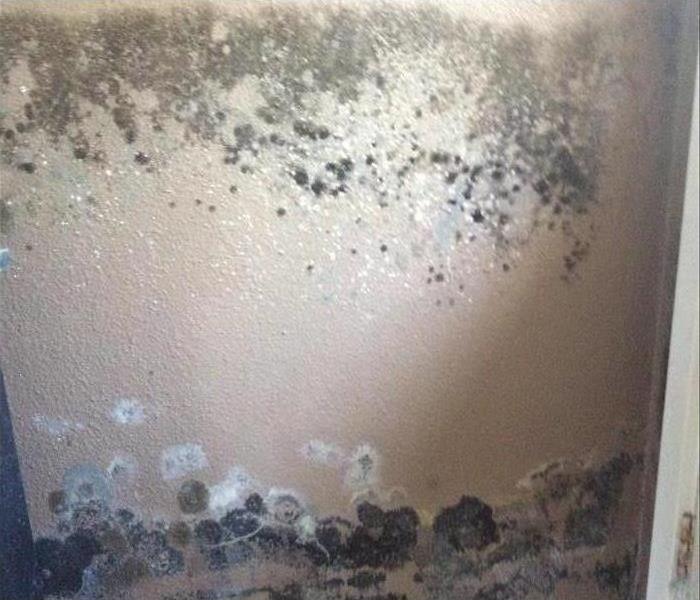 Mold damage in a Whitehouse, TX home
Mold damage in a Whitehouse, TX home
How Mold Spreads in a House
Mold is a common household problem. Each year, 9 million homes across the U.S. have water damage that causes mold growth. Mold can enter your house through cracks in the foundation or walls, gaps around pipes and wires, or even tiny openings in windows and doors that weren’t properly sealed during construction. Once it’s inside your home, mold spores can spread quickly throughout the building because they get everywhere.
How Mold Spreads
Mold spreads through spores. Spores are tiny pieces of mold that are released into the air or on surfaces in your Whitehouse, TX home, and they can travel quite a distance before they land. Spores are invisible to the naked eye so you may not know that they're floating around your house until they've already begun to grow into new molds.
Active vs. Inactive Mold
Active mold is known as a "hyphal" form of the fungus. This is what you see growing on your moldy bread, or in the corner of your shower stall. In fact, if you open your bathroom cabinet and see what looks like white cotton balls growing on some old papers inside—it's more than likely that you have active mold in there.
If left alone, this type of fungal growth will continue to spread across surfaces until it reaches every nook and cranny of your home (which means it can grow behind walls too). If any part of its "root system" gets exposed to moisture or warm temperatures (like those found near furnaces), it's likely that other sections will begin growing again as well!
Inactive mold doesn't look quite as gross when compared with active mold; however it can still cause health problems if ingested by humans or pets who may come into contact with contaminated surfaces/dust particles floating around them (such as cats licking themselves after rolling around on bedsheets covered with spores). This type usually occurs during rainy seasons because rainwater contains nutrients needed for survival amongst different types of organisms such as fungi species.
Mold Spreads Quickly
Mold spreads throughout a house quickly. It can travel through the air, water, or people's clothing. Mold spores are microscopic and can float in the air for several days before landing on an object to begin growing. They also float around in water and attach themselves onto wet surfaces like walls and floors - even if those surfaces aren't visibly damp anymore!
Preventing Mold Growth
In order to prevent mold growth, you should keep your home clean. Mold spreads quickly in a dirty environment. It also thrives in places with high humidity and moisture content. You should make sure that there is enough ventilation in your house so that the air can dry out properly, preventing mold from growing on surfaces such as carpets or furniture.
Mold spores are everywhere but only grow into colonies if their conditions are right. Keep pets out of affected areas until they have been cleaned up; they will often track spores throughout the house on their paws or fur!
If water damage occurs (such as leaks from roof top downpipes), clean it up immediately before it has time to seep into wall cavities where it won't be noticed until later when there's already too much damage done by then.
How To Use a Plumbing Snake
11/12/2022 (Permalink)
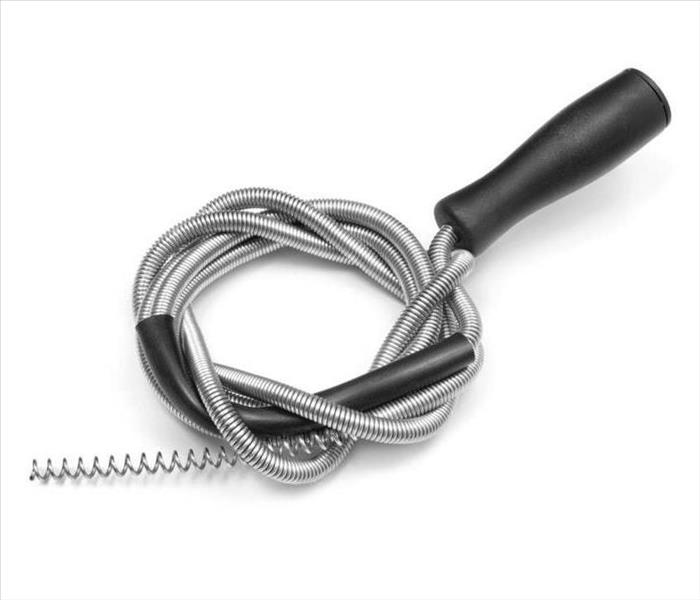 The process of using a plumbing snake is not complicated, but it does require some practice.
The process of using a plumbing snake is not complicated, but it does require some practice.
Using a Plumbing Snake
If you're having problems with your plumbing, the first thing to try is to use a plumbing snake. A plumbing snake is a long cable that has a handle on one end and an attachment for inserting into drain lines at the other end. It's an inexpensive tool that can save you from having to call in expensive professional plumbers or even tearing apart your walls in order to fix them. Just follow these steps:
Step 1: Choose Your Plumbing Snake
To begin, you will need a plumbing snake. You should choose the appropriate size for your pipes so that it can easily slide through them. The first thing you'll want to do is make sure the snake is in prime condition. The last thing you want is your new tool breaking down on its first day in action! To do so, take out any hair or debris clogging the tip of the pipe cleaner and carefully wipe down any dirt that may have gotten inside your tool (or caused an air bubble). You don't want this stuff flying into any other parts of your house!
If there is no water in your pipe, use a plunger first to clear any clogs or debris that may be blocking it. A bucket should be placed under the area where you are working to catch any water that comes out during this process. If using a wet/dry vacuum is not possible, consider using an alternative method by turning off your main water supply before removing clogs from toilets or sinks. This prevents damage if something goes wrong with your plumbing system during this process!
Step 2: Insert the snake into the pipe until you feel resistance.
Place one end of the snake over where there might be an obstruction blocking water flow in your system. Most likely this will be near where water enters or leaves from underground pipes; these areas tend not only to be more prone to clogs but also easier places through which mice can crawl if they've made their way into our systems as well (even though we'd rather them stay away). Make sure that both ends are pointed upwards towards where debris could be lodged within pipes; then gently push forward until resistance is felt on one side.
Step 3: Turn the snake clockwise.
Once you’ve inserted the snake, slowly turn the crank clockwise. You should immediately feel resistance as it encounters a clog in your drain. If you can’t feel any resistance at all, stop using the snake and call a professional plumber to remove whatever is blocking your pipe.
If you do feel some resistance from a clog but can't get it out with one try, keep going—it will come through eventually!
If nothing happens when turning this wrench and pulling on the cable with force doesn't help either, then it's likely stuck inside of whatever's causing the blockage in your drain pipe and may need to be removed manually by someone qualified for such work who has experience dealing with such plumbing issues.
Step 4: Extract the Snake
Once the cable has been pushed through and its entire length is in the drain obstruction, you'll need to let go of your plumber's snake. If there is too much tension on the line, start cranking counterclockwise to extract your plumbing snake from your pipe. This will pull any debris out with it and allow for easier removal in later steps.
The process of using a plumbing snake is not complicated, but it does require some practice. You will need to learn how much tension you can apply before it becomes too much for your line and the proper way to extract whatever was clogging up your drain. Once you have mastered this skill, however, it will be an invaluable tool when dealing with clogged drains or any other issue related to pipes in your home or office building.
If you find yourself in a water damage event because of the clogged drain, give SERVPRO of Tyler a call! We will get your Tyler, TX home back to normal as quickly as possible.
How Do I Protect My Business From Fire Disaster?
10/16/2022 (Permalink)
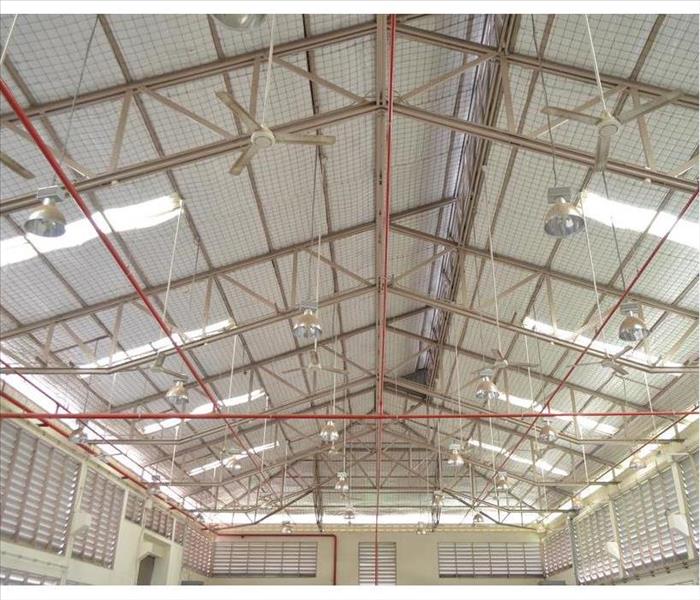 Install a fire sprinkler system
Install a fire sprinkler system
Fire Disaster and Your Business
Fire prevention is important to any business owner. You can protect your business by installing a fire sprinkler system, having a dependable fire alarm system installed, and having fire-resistant walls and ceilings. By taking these steps and more, you can prepare your company for the worst in case of emergency.
Install a Fire Sprinkler System
You should install a fire sprinkler system in your business. Fire sprinklers are an essential part of any building and can save lives, property, and money.
If you don't have a fire sprinkler system installed in your building yet, now is the time to get one. A fire sprinkler system will allow you to sleep at night knowing that your business is protected from a costly disaster. It also makes sense financially; if there's ever a fire at your place of business, installing a fire sprinkler system now will save you money down the road by reducing insurance premiums for years to come (and sometimes permanently).
Install a Dependable Fire Alarm System
You should always have an effective fire alarm system in place to keep your business safe, especially if it’s a large or high-risk location. If you do not have one yet, install one immediately!
Types of fire alarms
There are two main types of fire alarms: manual and automatic.
Manual systems require someone to pull the lever when there is a potential threat of fire, which then triggers a call for help from local authorities and other emergency responders if necessary.
Automatic systems detect smoke or heat signatures automatically without requiring human intervention; thus, they can be more efficient at detecting fires than manual ones. However, automatic systems can be more prone to false alerts due to their sensitive technology—especially if they're older than ten years old—and may not always reach authorities quickly enough in case of emergency situations such as earthquakes that cause structural damage but not necessarily fires themselves (although these events would still qualify as emergencies).
If possible, choose an automatic system with cellular backup capabilities so that even in cases where there's no power outage due to natural disasters like hurricanes Katrina and Sandy happening nearby - which happened near New Orleans back in 2005 - it'll still get signals out through radio waves instead via Wi-Fi connections being cut off by water damage caused by flooding during those storms
Install Fire Resistant Walls and Ceilings
One of the most important things you can do to protect your business from fire disasters is to install fire-resistant walls and ceilings. Fire-resistant walls and ceilings are designed to resist or prevent the spread of flames, smoke, and hot gases. They’re also useful in containing a fire if it does get started, which gives you more time to evacuate safely.
There are several types of fire-resistant materials available for walls and ceilings:
- Gypsum board (drywall) with a plaster finish applied over it
- Plasterboard (also called gypsum board) with an integral intumescent coating
- Rock wool insulation behind drywall with an intumescent coating applied over the top layer of plasterboard (gypsum board).
Always Have a Fire Extinguisher Handy
Use a fire extinguisher when needed. Read the instructions carefully and understand how to use your fire extinguisher before you need it. Know where your extinguishers are located and that they are in good working order. Check them at least once a year, or more frequently if you have reason to believe they may need it (e.g., if they were dropped). The manufacturer's instructions will tell you how often they should be checked or serviced by a professional, but every few years is probably fine as long as you keep an eye out for any signs of wear or damage, like cracks or rust spots that could cause leaks when you try to use them—and don't forget about those visual inspections. Make sure that all staff knows where the closest fire extinguisher is located and how to properly operate it in case of emergency—and make sure everyone understands its limitations: A fire extinguisher can only prevent fires from getting worse; it cannot put out an already raging blaze.
Fire prevention and preparation can save your business from suffering heavy losses. The importance of fire prevention can not be overstated. Fire damage can be very costly; if you have a small business, it may even put you out of business. Some types of businesses are more susceptible to fires than others. For example, restaurants and bars often have grease fires due to cooking equipment or flammable liquids like alcohol used in drinks. But any type of business could suffer from a devastating fire if they don't take the proper precautions against one happening:
Hopefully, we have shown you just how important it is to take fire safety seriously. The last thing that any business owner wants is to lose everything they’ve worked for. With these tips, you can rest easy knowing that your business will be safe from fire disasters.
If your Tyler business does catch on fire, SERVPRO of Tyler is here to help you clean up the mess and get back to normal.
What To Do When You Lose Power
8/31/2022 (Permalink)
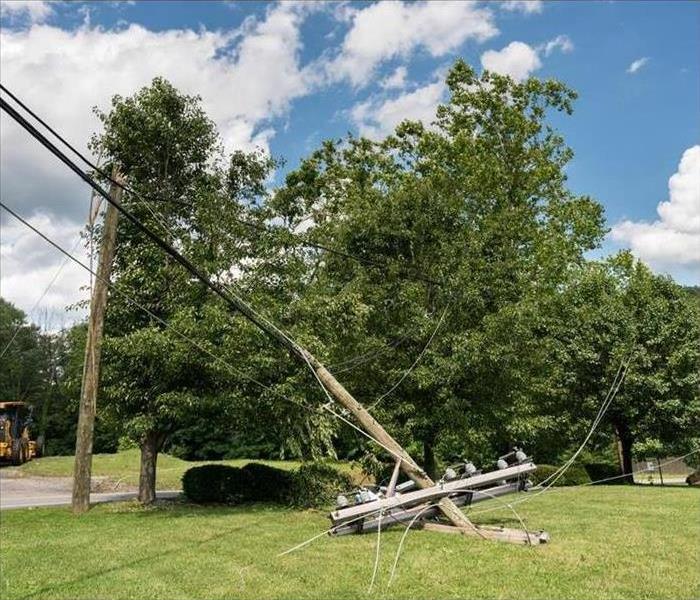 Power outage in Whitehouse, TX area
Power outage in Whitehouse, TX area
What To Do When You Lose Power
Ice, snow, and high winds can wreak havoc upon power lines. Storm season means an increased chance of a power outage. Losing power at your business in Whitehouse, TX, doesn't have to mean losing valuable data or working hours, though. There are a few things you can do to make sure all your files are saved and accessible for workers.
Have a Generator
Every building should have at least one portable generator that can keep the power going when the municipal supply is cut off. A backup generator can help maintain electricity to various items:
- Basement sump pumps
- Office equipment
- Lights
- Computers
- Heating system
- Fire system
A generator not only keeps your business running but also keeps your building protected from certain hazards that may accompany the storm. If the basement floods, for example, remediation experts can resolve your problem faster if you have a working sump pump to remove most of the water before they arrive. You can save a lot of money on repairs and lost revenue if you can maintain basic functions after a power outage.
Seek Alternate Sources
Between the time when the power goes out and the generator kicks in, it's helpful to have sources that can help employees save what they're working on. Plugging each computer into an uninterrupted power supply does just that. The UPS lets the device run on its battery until another power source can take over. Because it's difficult to predict how long you may be without power, especially if you don't have a generator, it's important to make sure that the battery is strong and that employees only use their computers for essential functions so that it can last as long as possible.
A power outage doesn't have to spark widespread panic as employees lament the loss of documents they worked hard to create. By taking a couple of precautions, you can implement solutions that outlast the blackout.
Places in Commercial Buildings Where Mold Is Likely To Grow
8/29/2022 (Permalink)
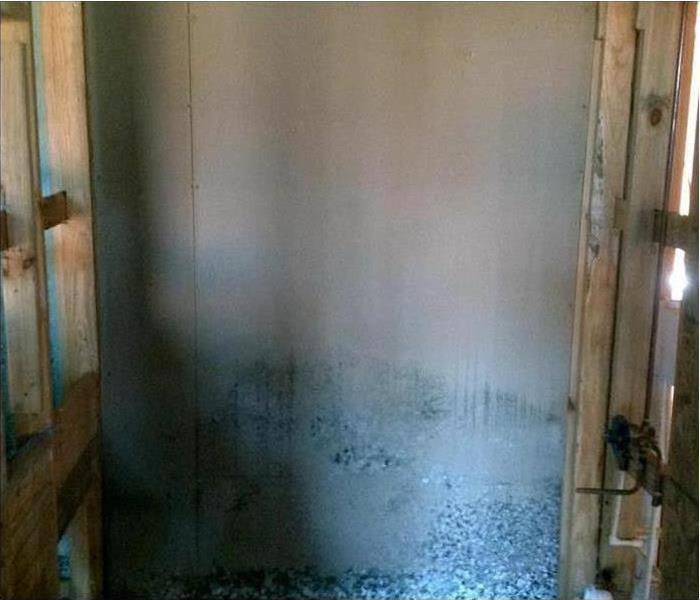 Mold growth in commercial property
Mold growth in commercial property
Areas Where You Can Find Mold
Mold is in every building, a presence in the air people breathe even if its growth cannot be perceived by the naked eye. Once it becomes visible, it poses a risk overtime to the structural integrity of commercial property because it degrades construction materials like wood, glue and fabrics. This can be financially costly to business owners, so the discovery of mold growth usually prompts them to contact a professional cleanup service in Troup, TX, for mold remediation. The fungus is not always in an easy to spot location, but there are certain areas where it is more likely to be found.
Locations With Moisture
Besides causing water damage, leaks and large inundations of water also cause harm by promoting mold growth. The invasive mold loves dark, wet and cold spaces. Any place with a lot of moisture and/or high humidity carries a high likelihood of having it, including public or employee bathrooms or around pipes.
Locations Associated With HVAC Systems
HVAC systems themselves and places connected to them are mold breeding grounds because of condensation. This includes:
- Ducts attached to HVAC systems
- HVAC terminal units
- HVAC drain pans
- Ceiling tiles around HVAC systems
Locations That Trap and Hold Water
Building materials often trap and hold water, creating environments conducive for the development of the ubiquitous fungus. Carpets and the lightless spaces behind walls, for example, often hold mold that goes unnoticed for long periods of time. It is also not uncommon to find it in insulation or wallboard.
Mold growth is bad news for a building. It eats away at materials, creating a need for repairs and, in some cases, replacement. It is also impossible to fully remove, though qualified professionals can remove the parts that can be seen. It is important to know where mold may grow, especially the less accessible areas that may not be looked at as often. This way such areas can be checked, and mold discovered and dealt with before spreading further.
Can a Fire-Damaged Home Ever Get Back to Normal?
8/24/2022 (Permalink)
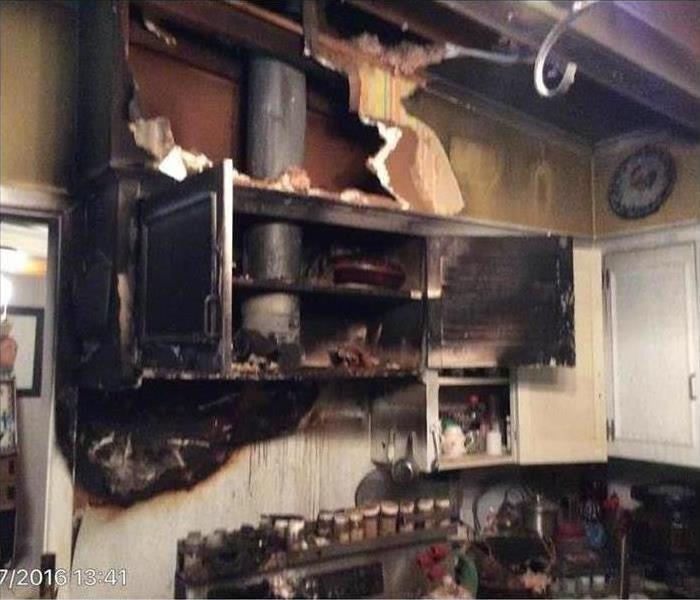 Fire damage in a Tyler, TX home.
Fire damage in a Tyler, TX home.
Four Steps Fire Restorers Use To Fix Fire Damage
Few things are more heartbreaking than going through a home fire. If your home in Texas has gone through ablaze, whether due to bad electrical wiring or oil fire, it may be a literal shell of its former self. You may wonder if your smoke-damaged home can ever get back to normal. Fortunately, by working with a fire restoration company, you can increase your chances of returning your home to its pre-burn state.
1. Survey the Damage
As you may know, fire restoration firms play no part in extinguishing your home’s blaze. Instead,
firefighters work hard to check your house for inhabitants and stop the destructive fire. After firefighters leave, restorers survey damage. They also board up doors and broken windows to keep criminals from causing additional damage.
2. Clean Personal Belongings
Because your smoke-damaged home is likely not safe or inhabitable, restorers remove salvageable
belongings to clean them off-site. Then, using specialized cleaning products and techniques, restoration technicians remove smoke from your keepsakes.
3. Restore Walls and Floors
Homeowners are often surprised to realize that fire-suppression activities can cause more damage than the fire itself. Restorers work hard to remedy smoke and water damage. Often, they must paint walls and renovate flooring.
4. Tackle Lingering Smoke Odor
Even weeks after a fire, smoke odor can linger in your smoke-damaged home. To encourage a fresh,
clean scent, restorers use ozone and thermal fogging techniques. They also spend time deep cleaning your home’s heating and air conditioning systems. Likewise, with the help of high-powered filters and fans, fire restoration techniques remove small soot particles from your home’s air. After workers finish, homes often smell like they never burned.
Returning your fire-damaged home to normal involves more than simply cleaning soot from walls. When you work with a skilled restoration service, you take advantage of expertise and equipment to recover from your devastating Tyler, TX home fire.
The Relationship Between Fire Damage and Water Damage
7/31/2022 (Permalink)
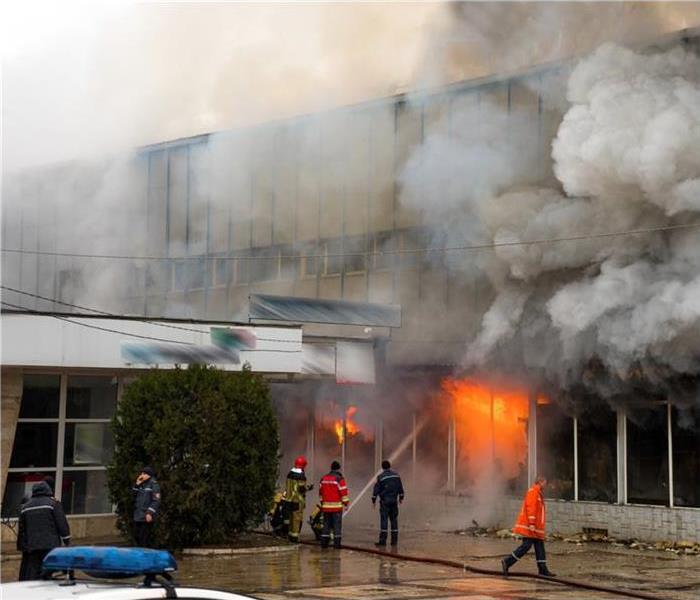 Commercial fire damage in Arp, TX
Commercial fire damage in Arp, TX
You've probably heard the saying, "Where's the smoke, there's fire." In the case of an office building fire, you could say, "Where's the fire, there's water." Experiencing a fire can be a scary event. Even small blazes can cause extensive fire damage. Thankfully, fire crews have the skills and equipment to extinguish the flame. However, this can introduce a new set of problems.
How Fires Start
If there is fire damage in your office, there are a few likely culprits for the incident. Office fires commonly start in the following ways:
- Electrical system problems
- Improper disposal of flammable materials
- People smoking cigarettes on the premises
The Consequences
A fire can rage through your office quickly and destroy building materials, furniture, documents, and electronics. The smoke damage can be just as harmful. Smoke leaves soot and ash on the floor, equipment, and other surfaces. You'll need to hire a professional disaster mitigation company to handle the cleanup and restoration efforts. The pros will tear out ruined building materials and other items. Technicians can salvage some equipment and supplies.
Water: A Help and a Hindrance
You'll be grateful for the firefighters in Arp, TX, and the water they use to put out the fire. These responders put out a lot of water from each fire hose. This method can be effective at eliminating the fire, but it also can cause further damage to your building. The water left behind can destroy computers, printers, carpets, and documents. If you don't clean up the water quickly, mold can start to grow.
A Professional Touch
The good news is professional cleanup technicians are experienced and skilled in removing any standing water. The company will mitigate the water damage in your office while cleaning up after the fire as well.
Along with fire damage, water can cause problems after a fire in your office. Be aware of the possible consequences and enlist the help of a water removal team.
6 Steps to Preserve Wood Floors from Water Damage
7/26/2022 (Permalink)
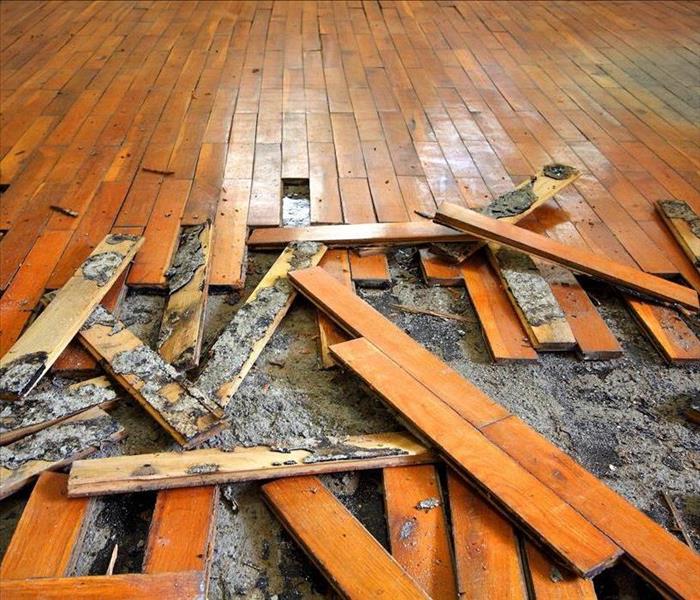 Wood floor damaged by water.
Wood floor damaged by water.
Steps To Help Prevent Long-Term Damage
Wood flooring can bring a pleasing aesthetic to your Troup, TX, business. While durable and long-lasting, it does have a weak point: water. If your business experiences a pipe burst, the wood floor will rapidly begin to absorb the water. If left unchecked, it can quickly lead to staining, cupping, buckling, and cracking, which could mean costly repairs. Below are steps to help prevent long-term damage.
1. Removed Saturated Items
The moment you notice a wet floor, quick action is necessary. Immediately remove any rugs or furniture. Leaving them in place will result in more moisture being absorbed in the floor, as well as increase the chances of mold or mildew growth.
2. Soak Up the Water
Use whatever you have on hand to soak up as much water as possible. The longer standing water remains, the more chances your floor will be damaged. It is important to consider the type of water. If there is any potential for contaminants, extra safety precautions should be taken.
3. Clean the Floor
Any debris or dirt left in the pores of wood flooring can store bacteria. Disinfecting the entire surface can help eradicate that potential problem.
4. Dry It Out
After a pipe bursts, open windows and fans can become your best friend. Increased airflow is essential for wood to dry out.
5. Perform a Moisture Test
Testing meters are available that display moisture levels. Depending on the extent of the damage and humidity levels, it could take weeks for the floor to completely dry.
6. Get Professional Help
Anytime your business faces excess water, it is worth contacting a water and mold damage expert. Along with ensuring your wood floors are properly cleaned and dried, they will be able to locate any hidden water damage that may have made its way into the walls or under the floor.
While a pipe burst is a massive hassle, taking quick action is imperative to avoid long-term damage.
How To Conduct an Emergency Drill at Work
7/21/2022 (Permalink)
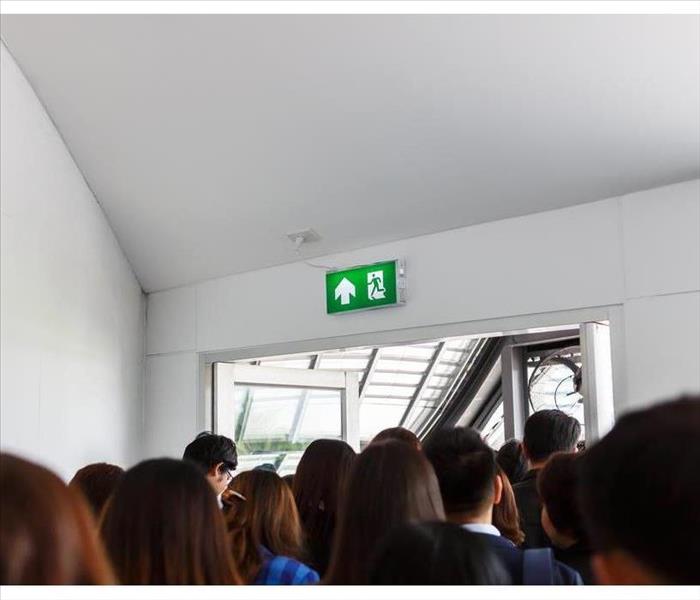 Make sure all employees are trained to know where to meet and how to get there.
Make sure all employees are trained to know where to meet and how to get there.
Creating a fire drill procedure is the best way to make sure your employees and visitors get to a safe place quickly in case of an emergency, such as a fire or other disaster. When developing the plan, include the following steps for an effective evacuation.
Steps To Follow When Creating an Evacuation Plan
Alert your local fire department before you conduct a drill. The Fire Marshall will be happy to visit your facility and give you helpful suggestions so that you can identify the best evacuation routes to get people to safety quickly.
Develop a safety committee and make sure to meet regularly. It’s important to include a person from each department and shift who will account for employees at the designated meeting places outside the building. Once evacuation routes have been established, post the fire drill paths with maps in all areas of the facility.
Make sure you have a reliable alarm system that everyone in the building is able to hear. In areas where the noise level is high, or if you have an employee who is hearing impaired, you need to make sure there are flashing lights or another visual alarm that can’t be missed. Alarms should be checked periodically to ensure they are working properly.
Make sure all employees are trained to know where to meet and how to get there. Conduct a drill periodically to ensure that everyone is accounted for quickly and efficiently. Don’t forget to account for all the visitors in your building. Having a sign-in sheet at the reception area will help identify all visitors to your business.
Steps To Making the Plan a Success
When you are implementing a fire drill plan, it is important to repeat the exercise several times so that your employees become comfortable with the process.
What Are the Standards for Preferred Vendors?
6/28/2022 (Permalink)
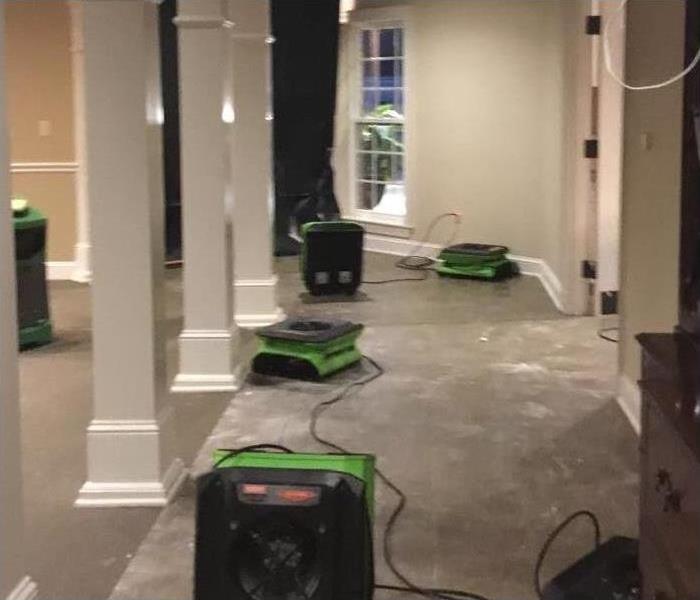 Water damage cleanup in Tyler, TX.
Water damage cleanup in Tyler, TX.
What Criteria Are Used to Select Preferred Vendors?
An insurance agent and commercial property owner can both benefit from using a trustworthy restoration company. The SERVPRO National Accounts Division maintains stringent qualification compliance and professional standards. Rigorous requirements for participation such as training, background checks and high quality of service can make a nearby franchise the right choice for restoration work in Tyler, TX.
Background Checks and Internal Audits
Employee background checks and internal audits are among the main requirements for restoration franchises to participate in the National Accounts Division. These checks, along with other Participation Agreement requirements, have several purposes:
- Ensure the highest quality of service
- Guarantee insurers can rely on restoration service providers
- Increase claim coverage where possible
Franchise owners have the option to participate in the vendor program and to take jobs covered by insurance. Continued compliance with these requirements is necessary for ongoing program participation.
Fully Trained Technicians
Professional cleaning and restoration skills are another factors that is taken into consideration for determining preferred vendors. The Institute of Inspection Cleaning and Restoration Certification is available in a variety of divisions, such as cleaning, inspection and restoration, and specialized fields.
Longstanding Insurance Agent Partnerships
The high quality of service provided by individual franchise locations can make large insurance companies more likely to rely on franchises affiliated with the National Accounts Division in other locations. By consistently demonstrating a high quality of service across North America, this company has become a leading provider of restoration services associated with insurance claims.
An insurance agent can trust that preferred vendors will deliver the expected quality of service. From the reciprocal perspective, franchises must meet high internal standards to be eligible for working insurance jobs. The standards for vendor qualification compliance and professionalism that a corporation maintains can guarantee high-quality service at a franchise located in Tyler, TX.
How To Save Wet Documents After a Flood
6/21/2022 (Permalink)
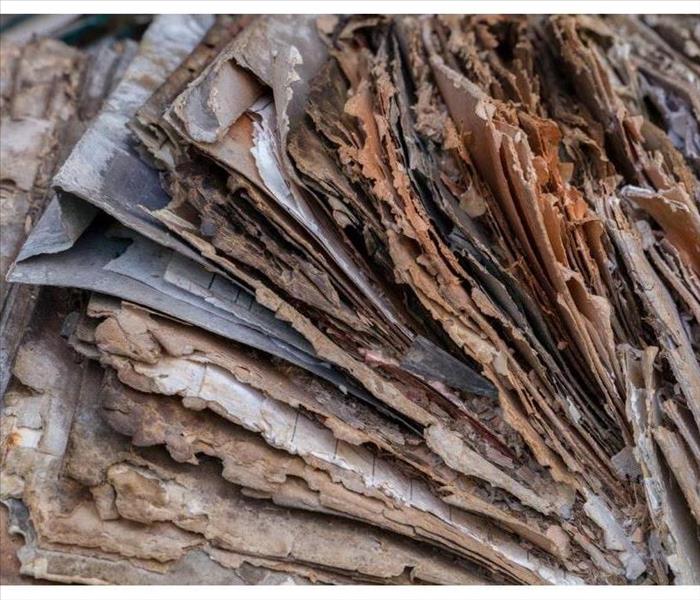 Salvaging wet documents is possible when following a thorough process.
Salvaging wet documents is possible when following a thorough process.
How To Salvage Wet Documents
When your business suffers from water damage, the building must undergo a cleaning and restoration project, as well as any valuable items that appear ruined. Salvaging wet documents is possible when following a thorough process. Here is what you need to know if you need to save flooded documents within your Arp, TX, commercial space.
1. Get Wet Documents to a Freezer
The first key step to saving your paper items is getting them in a freezer as quickly as possible. Taking swift action here prevents the document from deteriorating as well as producing mold or bacteria if it remained wet. After you've got your items in a freezer, contact a local water damage restoration expert who will then transport the documents to a state-of-the-art facility that specializes in document drying. Their specially designed vacuum-freezer will suck any remaining moisture out of the paper for advanced restoration.
2. Gamma Irradiation Cleaning
If your documents came in contact with wastewater or outdoor flooding, they will be inundated with harmful bacteria, pesticides and other dangerous properties. Experts will employ what's known as gamma irradiation to kill off any biohazards and sterilize the paper once it has been freeze-dried. This step is critical for eliminating any health risks associated with water damage.
3. Produce Digital Copies of Documents
Once your items have undergone drying and sterilization, restoration professionals will then produce digital copies. This offers peace of mind to business owners who can now easily access their documents digitally and don't have to worry about their hard copies becoming damaged in the event of another flood disaster.
If your commercial space experiences a water issue that has compromised valuable papers, it's paramount to immediately place the wet documents in a freezer. From there, let professionals step in with specialized vacuum-freeze drying, gamma irradiation cleaning and digitizing of the documents.
Flood Cuts 101
6/7/2022 (Permalink)
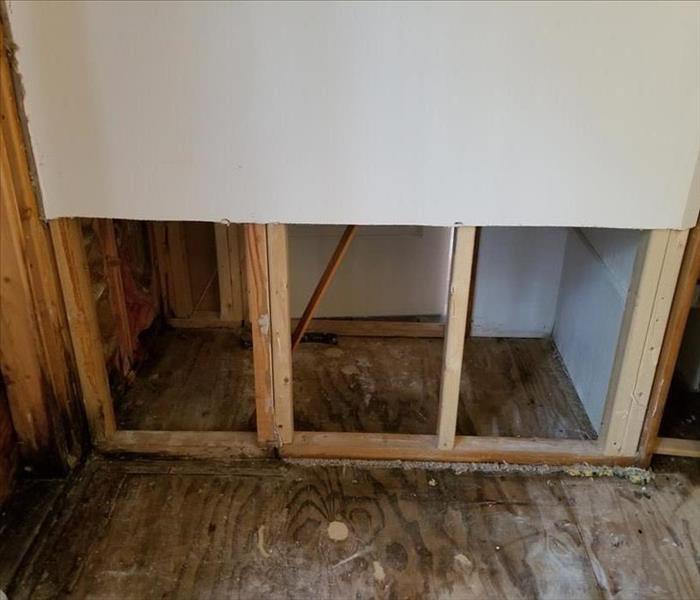 A flood cut was performed in a home in Flint, TX.
A flood cut was performed in a home in Flint, TX.
After flooding occurs at your Flint, TX, home, it may be necessary to tear out part of the drywall in the affected area to address contamination and other concerns. While the temptation to take a hammer to your soggy drywall may be (understandably) high after a flood, a flood cut is the smarter move.
What Is a Flood Cut?
When your preferred water damage restoration company gets down to work, one of the first things the team may want to do is make a flood cut to your drywall. This is a calculated cut performed at least 12 inches above the highest spot reached by the creeping water. Because of this, it typically results in half of the lower part of the wall being cut away.
Are Flood Cuts Necessary After Any Kind of Flooding?
Any time rising water affects your home, a flood cut may be required. That said, it's most commonly associated with severe weather events such as the following:
- Thunderstorms
- Tropical storms
- Hurricanes
- Rivers, lakes and streams overflowing
- Overflowing dams and similar barriers
What's So Bad About Rising Water?
There are two main reasons why rising water is a problem for your drywall. First, it's often classified as Category 3 water, a.k.a. black water, due to how highly contaminated it is. All water from storm surges and sewage, for example, is considered Category 3.
What's more, once the drywall is touched by Category 3 water, it's impossible to ever get it fully clean. This is due to its porous surface; once those pathogens or other toxins get in, they're never coming back out in their entirety.
After flooding, it's imperative to remove any sodden items from your home for the continued safety of everyone who lives there. This goes double for wet drywall. With a flood cut, trusted professionals gain better access to the source of the problem and will dispose of any contaminated building materials safely — and with zero involvement from you.
The PPE Worn During Mold Removal
5/27/2022 (Permalink)
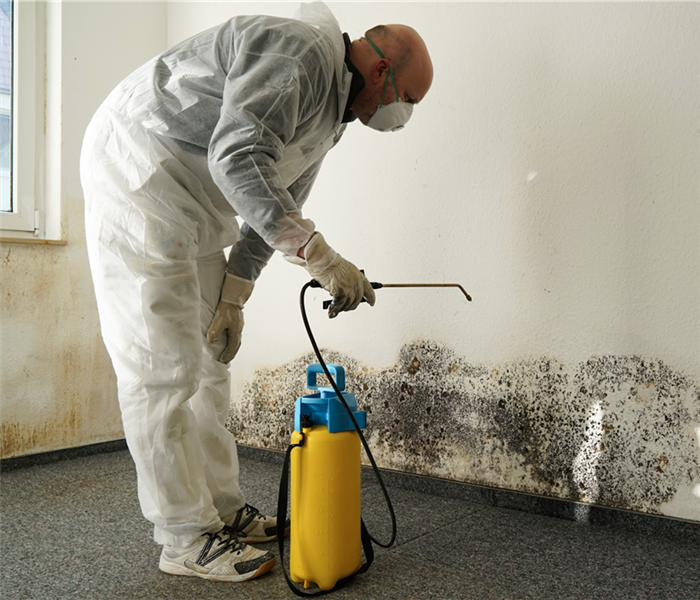 Professionals who are removing mold growth must wear standard PPE.
Professionals who are removing mold growth must wear standard PPE.
Personal Protective Equipment (PPE)
Personal Protective Equipment (PPE) is necessary to protect the workers from a remediation company when removing mold from a business in New Hope, TX. There are several pieces of equipment they will wear for any job, and there are several pieces that they will only wear for severe cleanups.
Standard PPE
Several PPE pieces are mandatory to protect workers and prevent the spread of spores during the mold remediation process. This includes:
- A hard hat
- Safety goggles
- Disposable gloves
- Shoe covers
- A respirator or face mask
Additional PPE
If a site is larger than 100 square feet, there is excessive mold or a substantial amount of dust will be generated, additional PPE pieces are required to protect workers. These should be worn over the standard PPE. One requirement is a more substantial face mask, with N, R, or P 100 filters. In the most severe cases, workers may also choose to use a charcoal-infused filter to prevent odors from lingering on their masks. They should also consider abrasive blasting respirators to prevent certain particles from being inhaled.
Another enhancement that can be made to standard PPE is non-vented safety goggles so that no debris or spores can get around the eyes. If harsh chemicals are being used, workers may also be encouraged to wear longer disposable gloves to reduce their exposure risk further. Aside from these upgrades, workers on more severe mold cases should also wear a disposable Tyvek suit to reduce their chance of coming into contact with spores and chemicals. They may also choose to upgrade their disposable clothing further by looking for suits that cover the head and feet.
Professionals who are removing mold growth must take several precautions to prevent contact with spores, chemicals, and other debris. For small tasks, this includes wearing standard PPE. For larger or more dangerous tasks, this includes standard PPE plus any additional PPE required.
3 Tips for Avoiding Cigarette Fires at Home
5/22/2022 (Permalink)
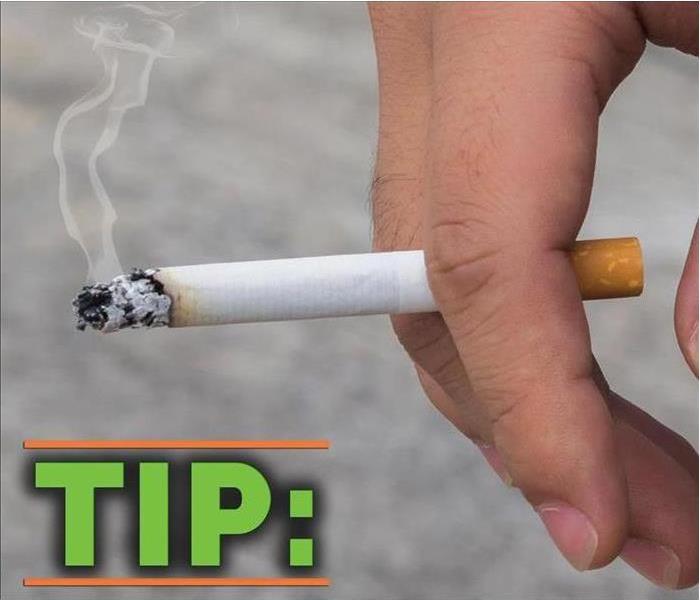 Cigarettes can leave lingering smells.
Cigarettes can leave lingering smells.
Cigarettes can leave lingering smells and even create a physical threat: Thousands of residential fires are linked to smoking each year. If it sounds frightening it should! But you have options. Read on to learn how, with just a little extra care, you can avoid your, Bullard, TX home becoming a victim of a cigarette fire.
How Does Smoking Cause Fire?
Smoking may not be the best habit, but you may wonder, how can it cause a fire? There are a variety of ways, obvious and not so obvious. Cigarette butts can ignite:
- Trash
- Dry underbush outdoors
- Improper ash cans
And much more. A cigarette fire can quickly rise from a small event to a full conflagration, so it’s best to take steps to avoid any flames.
Smoke Outdoors
Believe it or not, some folks still smoke indoors, especially at home. Asking members of your family to smoke outdoors removes the risk of an ashtray fire, or of butts or ashes igniting curtains, books, furniture or any other flammable items. It may also leave your house smelling better.
Never Smoke Sleepy
Smoking can be a relaxing pre-sleep ritual for some, but it can come at a high cost. Falling asleep on a couch or in a bed with a lit cigarette can lead to embers igniting fabric. The results can be fatal.
Don’t Use Plants as Ashtrays
It can be tempting, if you’re smoking in the backyard, to toss your butts into the grass. But dry leaves can easily catch fire from a smoldering cigarette butt. Instead, find an ashtray or stamp your butt out.
Smoking remains a common habit and one that can pose a significant fire risk. Learn what not to do. Use the tips above and, should your home be damaged by a cigarette fire, call remediation specialists quickly for fire cleanup you can trust.
3 Steps To Take When Your Roof is Damaged by a Fire
5/17/2022 (Permalink)
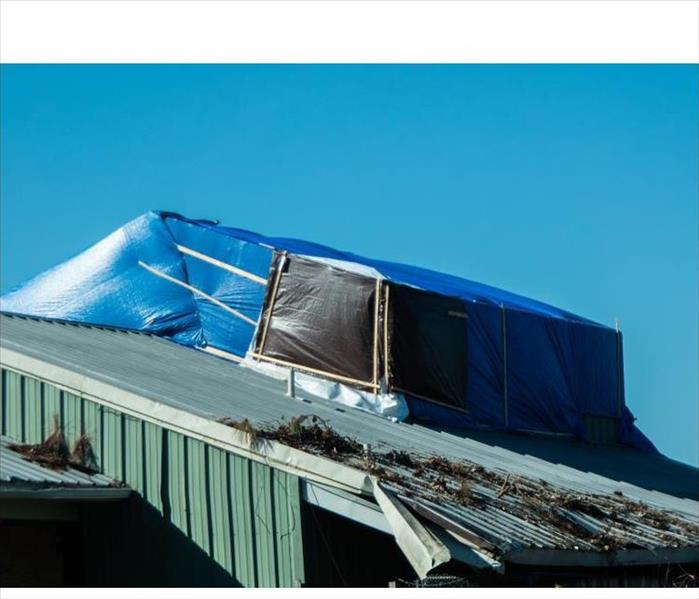 Roof tarping services in Whitehouse, TX.
Roof tarping services in Whitehouse, TX.
What To Do When Your Roof Has Been Damaged By Fire?
Your roof is one of the most important parts of your building. It protects the interior of your structure from the outside elements and helps control the interior temperature. Fire cleanup and repair are important for restoring your roof to its full function.
1. Cover Damaged Areas With Tarp
It may take some time before roof repair can be completed. Covering damaged areas with a tarp prevents rain, snow, hail or animals from getting in your building through openings and causing additional damage. Your property insurance will probably cover the cost to place a tarp. If you have a large surface area that needs covering, you may want to contact a fire restoration service in Whitehouse, TX, for tarp services.
2. Perform Fire Cleanup
If your roof was severely damaged, there is probably a lot of debris inside your building that needs to be cleaned up before repairs can begin. Most cleanup should be done by professionals. However, you can start getting the area ready by removing damaged contents and cleaning walls and floors. If the building has structural damage, do not try to begin cleanup until the fire department has inspected the building and said it is safe.
3. Take Steps To Prevent Future Damage
Now is a good time to take some steps to reduce your chance of future fire damage. Implement a maintenance program to fix roof leaks promptly. Holes in the roof can allow embers from a fire to get under the roof where framing, insulation and other flammable materials can ignite. Keep your roof clean. Debris, such as leaves and pine needles, can catch fire during lightning strikes or dry conditions. This is particularly important if you have a flat roof that accumulates a lot of debris.
The fire cleanup process can be lengthy and frustrating. However, taking these steps can protect your property from unnecessary additional damage.
3 Ways To Help Your Insurance Agent
4/27/2022 (Permalink)
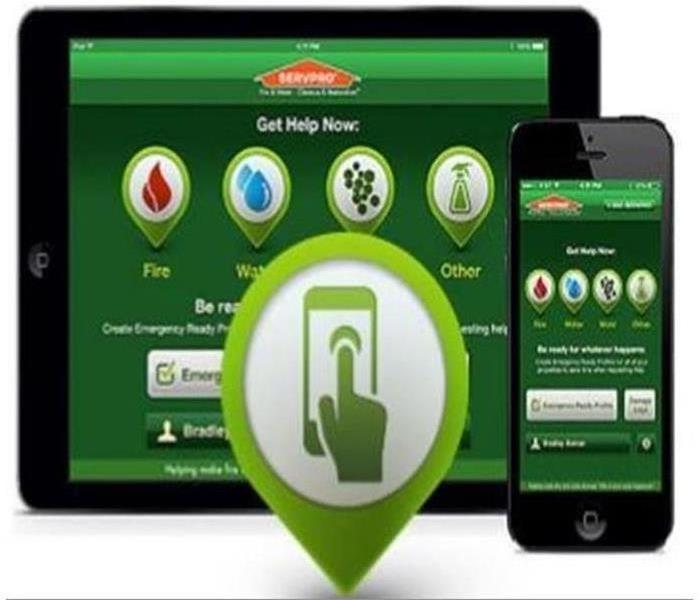 Whenever you file an insurance claim, it is a business transaction.
Whenever you file an insurance claim, it is a business transaction.
Three Things You Can Do To Assist Your Insurance Agent
Whenever you file an insurance claim, it is a business transaction. Instead of dealing with a partner, you're working with a company looking to make money. While you should always give your insurance company a chance to do the right thing, don't mistake your adjuster for a teammate. They are trained to control the payout you get. They are happy to take advantage of business owners who are overwhelmed by losses and the claim process. However, there are some steps you can take to help your adjuster give you a fair payout.
1. Understand Your Coverage
As soon as possible, get and read your business' policy for your site in Troup, TX. Look for the declarations page that lists your business information, policy number, and coverage amounts. This will be hard to read, but it can help you understand what is covered by your insurance. For instance, it will tell you how much you can spend on hiring a restoration company, such as SERVPRO, how the claims inventory system works, and what inventory is covered.
2. Network
If this is your first insurance claim, seek out other business owners who have made them. Learn from these people. Try to glean as much information as possible. Find out what their adjuster told them when they were in similar situations. By networking, you can be on your way to a faster and fairer claim because you will be able to provide this information to your adjuster. Also, networking can help you in other ways. For example, it can help you decide which disaster remediation company is best for you.
3. Get Help When You Need It
Filing an insurance claim is not easy, and sometimes, it may be best to leave it to the professionals. Fortunately, your attorney will be able to help you with the process if you need help negotiating with your adjuster for a fair settlement.
An insurance agent is a trained professional working for a company looking to make money. This means you will need to take certain steps to help them give you a fair payout.
What NOT To Do After Water Damage Occurs
4/22/2022 (Permalink)
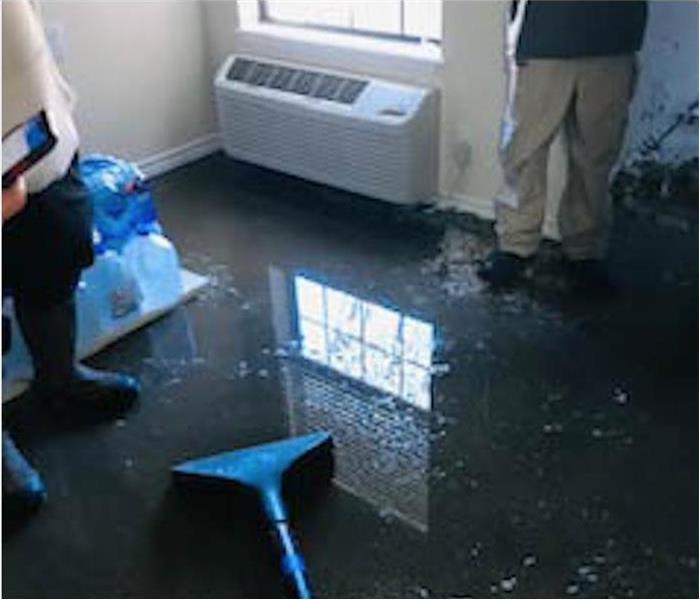 Powerful removal equipment allows us to remove standing water quickly.
Powerful removal equipment allows us to remove standing water quickly.
Secondary Damage Concerns Should Be Considered by Business Owners
If your home has experienced flooding in Tyler, TX, it's important to act right away. You know that you need to call your insurance company and that they will recommend a water damage restoration service that can help with your home repairs. Did you know there are some things NOT to do for the safety of you and your family?
1. Do NOT Use a Vacuum
You know it's important to remove standing water quickly in order to prevent damage. However, a regular vacuum cleaner is NOT the right appliance for the job. A shop vacuum that is intended for water may be used, but a vacuum that is meant for picking up dirt, even if it's a steam cleaner, is not safe to use to remove standing water in your home.
2. Do NOT Operate Appliances
A broken pipe that has led to flooding can compromise the electrical system in your home. Do NOT use the television, washer and dryer, or plugin other small appliances like heaters or hair dryers until a professional has determined that it is safe to do so.
3. Do NOT Leave Things on the Floor
Once you can safely enter the space that is flooded, do NOT leave items on the floor. Books and magazines can bleed color onto carpets and flooring. Rugs retain moisture and should be removed quickly. If possible, remove, or at least elevate, furniture to allow air to flow freely beneath the pieces.
4. Do NOT Take Risks
Cleanup from a broken pipe is important to prevent long-term damage, but doing so is not worth risking your health and safety. Do NOT enter rooms where the ceiling is sagging or where standing water is touching electrical appliances. Do not turn on lights, especially if water is leaking from the ceiling.
Flooding in your home is overwhelming, whether caused by a broken pipe or a natural disaster. Call for help and always take reasonable precautions to protect yourself from harm.
Mitigation and Restoration Are Essential Stages of Water Damage Cleanup
4/4/2022 (Permalink)
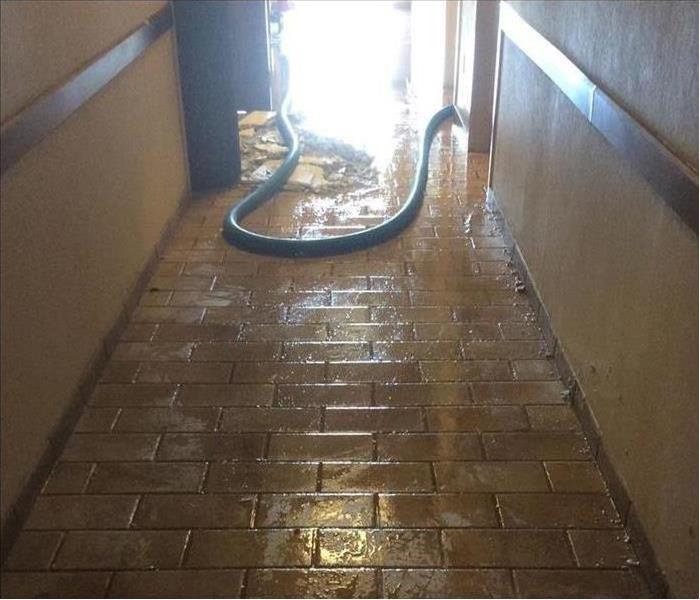 Flood damage in Arp, TX.
Flood damage in Arp, TX.
When a flood cleanup company examines a water-logged facility, the team should discuss two cleanup stages: mitigation and restoration. What are they different, and why are both vital to repair? It's probably tempting to dry everything out move on, but the specialists should explain that in cases of water damage, that effort isn't enough. Owners must consider both phases because prevention and rebuilding are vital to securing the area. Collaborate to establish a plan of action that gets your operations back up and running without concerns of future issues.
What Happens During Mitigation?
When the storm ends, and the water recedes, a restoration company should immediately attend to the property. The fluid from rain and floods permeates into porous materials. This lingering moisture, if not appropriately treated, permits mold, mildew and bacteria to develop. Rot and structural integrity could also become issues such as wood and ceilings. The goal of mitigation is to reduce the likelihood of these secondary conditions.
A flood cleanup company in Arp, TX, works with certified environmental specialists to assess the premises, testing to determine where contamination exists and how to treat it best. Within hours, the crew begins drying efforts. The workers should complete the following actions:
- Pull up saturated carpet
- Remove damp objects for content cleaning
- Toss soiled valuables
- Run industrial dehumidifiers
- Perform necessary flood cuts
Once the room is dry, the team scrubs the walls and sanitizes them with antimicrobial spray.
How Is Restoration Different?
While the early efforts focus on minimizing further concerns, the restoration company concentrates on mending the physical structure. This part of the project is slower. In remediation, crew members accomplish tasks at the same time. During the restoration, workers rebuild. Often, workers complete one thing before moving on to the next. Staff members replace anything pulled out, patch the walls and add a coat of paint. They also return any valuables that they salvaged.
A flood cleanup company understands that preventative measures are necessary. Their efforts with mitigation save owners future hassles. It's tempting to want to dry and paint, but taking time to care for the space is vital.
How To Prevent Mold Growth in Commercial Facilities
3/31/2022 (Permalink)
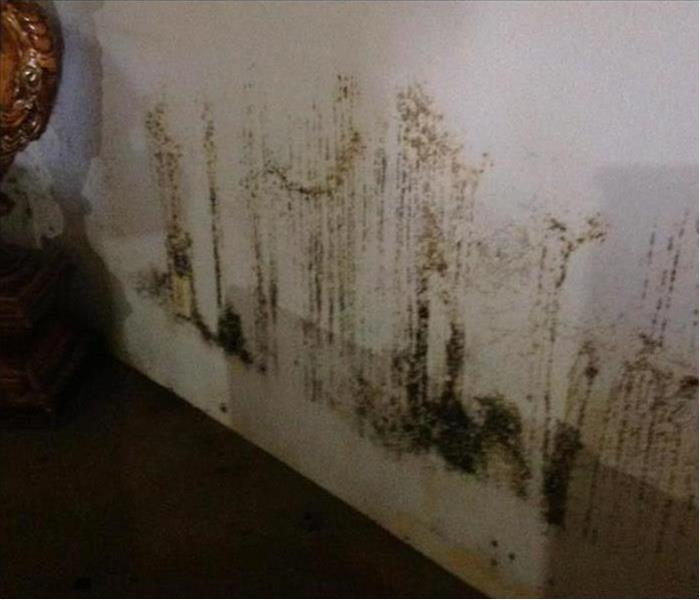 Mold growth after flooding in Flint, TX.
Mold growth after flooding in Flint, TX.
Mold Prevention Plan
To keep your Flint, TX, facility running smoothly, you need to practice mold prevention strategies. Unfortunately, this is often easier said than done. That is because mold is common in commercial facilities. These properties typically feature the four ingredients that mold needs:
- A surface
- Darkness
- Moisture
- Organic nutrients
Any lingering dirt or dust in your building provides the nutrients mold loves. Combine that with a dark room and a small leak, and you could quickly end up with a mold problem. Below are some common location for mold growth in facilities and how you can limit the spread of the fungus in those areas.
Electrical Equipment
Mold can appear in the electrical conduit following a flood. However, even just inviting warm, moist air near outlets, lighting fixtures and switches can cause the fungus to appear. Any water near electrical equipment should be dried right away. You should also seal and caulk the spaces around outlets to block moist air.
Carpets
Keeping carpets dry is another key part of mold prevention. Carpets can get wet following a major water damage or a minor spill. If a carpet is soaked for less than 48 hours, experts should be able to remove the water with a wet vacuum. However, a carpet that has been contaminated by sewage water should be replaced.
Drain Pans
Drain pans should collect condensation from the HVAC system. However, if the pan clogs, mold could quickly develop. Clean the pan regularly to prevent dirt from blocking the drain line.
Humidity can also cause a carpet to get moist. If you suspect that this is happening, increase the temperature or airflow in the room so the moisture evaporates.
You can limit mold growth in your facility by reducing moisture and cleaning up any excess water immediately. As part of your mold prevention plan, you should check dark and dirty locations regularly for signs of wetness and address them quickly. If you do notice any mold during your inspections, have commercial restoration experts clean the area immediately before the fungus spreads.
4 Reasons Flood Cuts Are Important
3/27/2022 (Permalink)
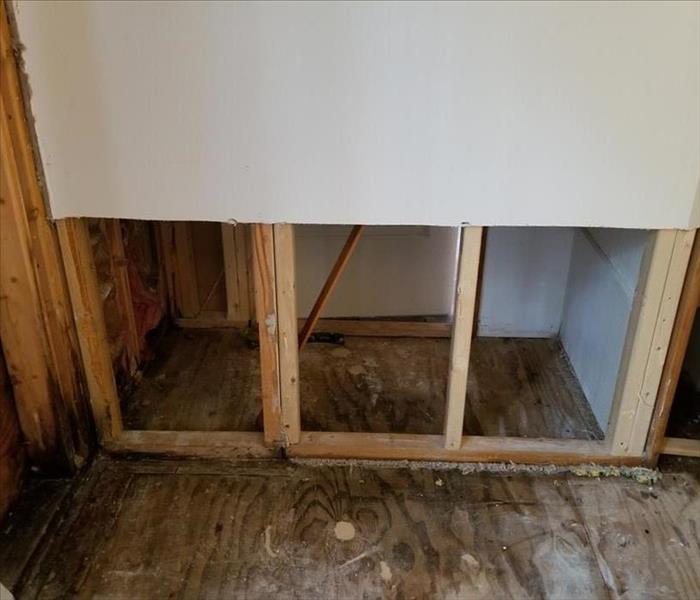 Flood cuts performed in New Hope, TX.
Flood cuts performed in New Hope, TX.
Flood Cuts Are Important For 4 Reasons
Enduring flooding can be a devastating experience for any homeowner in New Hope, TX. Salvaging the remains of your home once waters recede can also be extremely daunting. To safeguard your residence from additional damage, promptly initiating the flood cleanup and restoration process is essential. This may include making flood cuts on damaged walls. While this practice may appear destructive, tearing out saturated drywall is often an important procedure that shouldn’t be ignored.
1. Eliminates Contaminated Objects
Floods can introduce unsanitary water and debris into your home, creating an unhealthy environment for you and your family. Completing a tear-out on every affected wall helps eliminate potentially detrimental contamination.
2. Ensures Removal of Wet Materials
Because drywall is porous, water can easily seep through the structure and saturate underlying insulation. This may be problematic because wet building materials can easily become breeding grounds for mold. To alleviate this subsequent flooding concern, it’s essential to promptly remove all water-damaged items. Cutting the wall 12 to 18 inches above the highest water level ensures that all damp objects are efficiently removed.
3. Reduces Risk of Hidden Mold
Mold thrives in moist environments, often proliferating undetected in hidden zones. Failure to complete necessary flood cuts and remove saturated building materials can result in extensive growth. A large colony can compromise your home’s structural integrity, resulting in additional destruction.
4. Enables Moisture Verification
Eliminating excessive moisture is a crucial cleanup procedure. Removing wet drywall and insulation helps the affected area dry more efficiently. It also allows restoration experts to verify the absence of moisture throughout the water-damaged space before finalizing repairs, further reducing the risk of mold contamination.
Flooding can be an unexpected and extremely destructive event. Recognizing the importance of performing flood cuts and eliminating saturated building materials can help every homeowner commence cleanup operations quickly and efficiently, sparing their homes from mold proliferation and potentially costly remediation needs.
Fighting Smoke and Odor Damage After a Commercial Fire
3/22/2022 (Permalink)
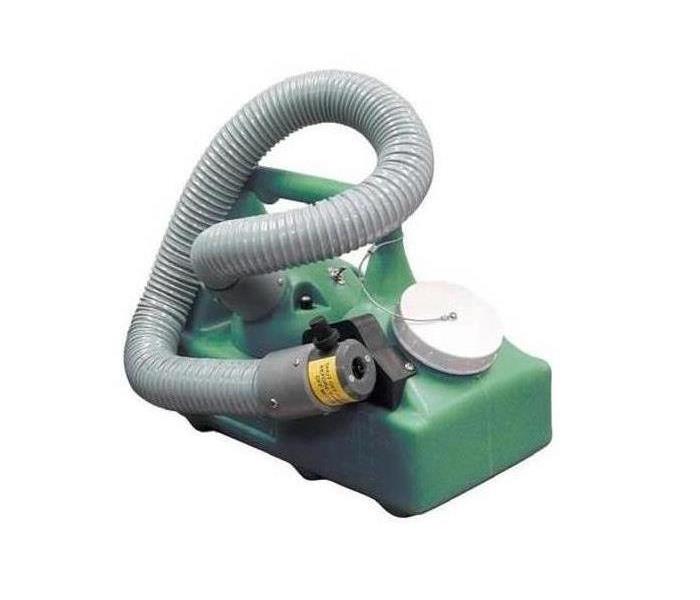 Thermal foggers can send cleaning vapors into tiny cracks and crevices where smoke can hide.
Thermal foggers can send cleaning vapors into tiny cracks and crevices where smoke can hide.
Removing Smoke Odor After a Commercial Fire
After a fire at your commercial building in Bullard, TX, there is often a long list of tasks you must take care of before you can reopen your business and get your company back in operation. If there was no structural damage to your building, removing the water may be foremost on your mind, but once the water is gone, what about the smoke cleaning and terrible odors that penetrated everything during the fire? Contact a professional team of fire remediation and restoration specialists to quickly remove the smoke damage and stains. Here are three of the methods they may use to combat the odoriferous problem.
Air Filtration
With the use of specialized screens, an air filtration system can actually scrub the air and remove lingering odors. The unit works by pulling the dirty, smoke-filled air into the machine with a powerful fan. The air is then passed through a filter that removes the smoke odor and cleans the air. Once the offensive particles are removed, the clean air is returned to the room. To make sure the filters are especially effective, they are often filled with specially treated charcoal.
Ozone Treatment
Ozone treatments do smoke cleaning by using a machine that sends a thick layer of ozone into the room to cover everything the huge oxygen molecules can reach. As the odors and ozone meet, oxidation occurs that chemically alters the problem smoke. This process can also disinfect problematic areas.
Thermal Foggers
Thermal foggers can send cleaning vapors into tiny crack and crevices where smoke can hide. By sending heated deodorizer out into the room as a foggy vapor, the large cleaning particles can chemically attach themselves to the molecules of the smoke and soot that filled the room in hidden or hard to reach areas. The fog can also permeate many solid items that may have absorbed the fire’s smoke.
By using one of the above three methods, a professional team can quickly remove persistent odors after a fire in your commercial building. Once the smoke cleaning is done, you can then get your building open and your company back in business.
Why Insurance Companies Like Working with SERVPRO
2/24/2022 (Permalink)
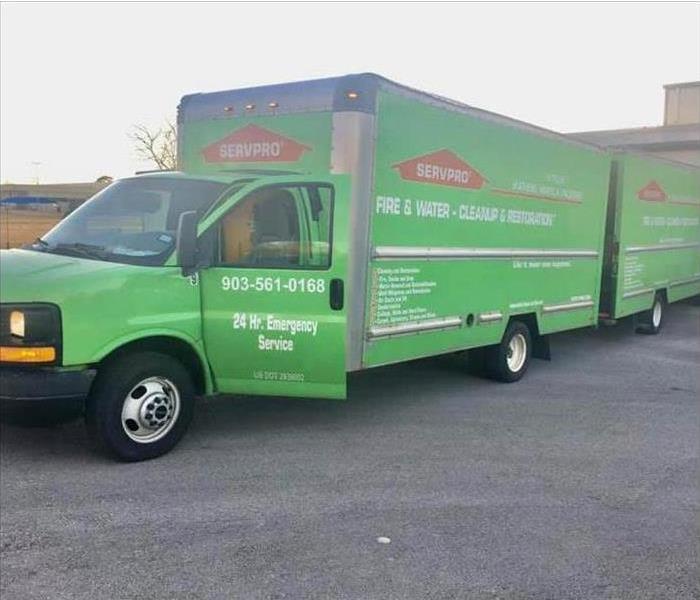 SERVPRO of Tyler is here to help.
SERVPRO of Tyler is here to help.
Why Do Insurance Companies Prefer SERVPRO?
As an insurance adjuster, you work in a constant state of balance between the needs of your clients and the needs of your company. When your client’s home in Whitehouse, TX, is damaged by a storm or fire, you are likely the first call the homeowner will make. You also have an obligation to your company to get as good a deal as possible. A vendor such as SERVPRO can help you satisfy both parties.
Keeping You Informed
The Claims Information Center is designed to keep you updated on every detail of the work being done on your client’s home. The job file includes:
- Initial damage assessment
- Response time
- Itemized list of losses
- Digital photos of damage
- Detailed cost estimate
While you want to complete your own walkthrough of the property as part of your responsibility as the insurance adjuster, the records from the CIC can be a valuable resource when your client files the claim. Electronic records make it easy to keep you informed throughout the process.
Keeping Communication Open
The 24-hour emergency call center makes it possible for you and your client to get the service and answers you need no matter what time of day it is. As soon as the service request comes into the call center, dispatchers notify local franchises to meet your client and start the restoration process.
Keeping Costs Low
Certified restoration specialists are trained to assess every situation thoroughly and restore whatever they can. By pretesting each item that is affected by the disaster, they can determine what can be salvaged. The fewer items that end up on the replacement list on the insurance claim, the lower your costs will be. The goal is to save as many items as possible.
SERVPRO is committed to working with the insurance adjuster to get the job done right. Choosing specialists who see the big picture is good for both your client and your company.
3 Ways to Know It’s Time to Replace Your Smoke Alarm
2/15/2022 (Permalink)
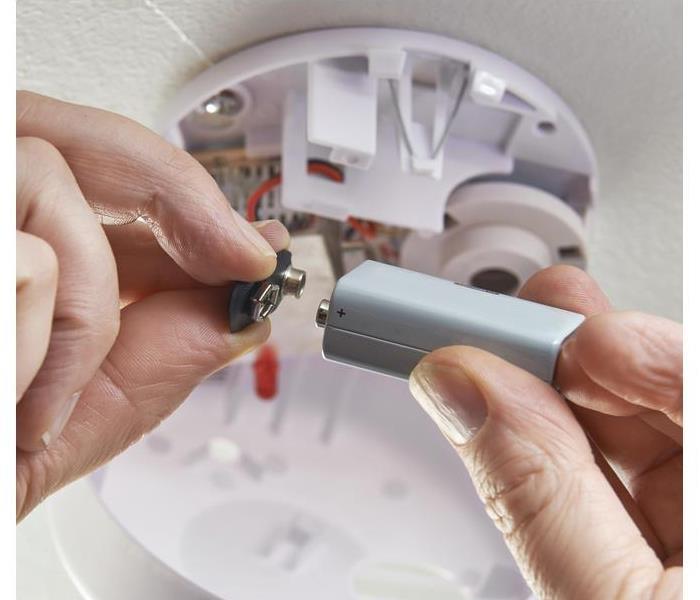 Remember to replace the batteries of your smoke alarm every six months.
Remember to replace the batteries of your smoke alarm every six months.
A fire or smoke alarm offers one of the simplest and most affordable ways to protect your home from fire damage. But to protect you, they must be in proper working order. Here are a few tips from the experts to help ensure the detector in your Troup, TX, home is in top condition.
The Reason for Smoke Detectors
It’s easy to forget why we have smoke detectors, until you have a fire. These tiny, ubiquitous devices do a big job in keeping us safe. According to safety experts:
- Three out of five home fire deaths occur in buildings where there is no working smoke detector
- Having a working fire detector cuts your risk of dying in a home fire in half
These sobering facts make it clear that you need to have a smoke alarm and make sure it works properly.
Know Your Alarm Type
How often you check your alarm depends a lot on the type you have. For an old-fashioned one powered by a 9-volt battery, be sure to replace the batteries every year. A lithium battery-powered alarm won’t need its batteries touched for a decade, while an alarm that’s hard-wired to your home’s electrical system will likely have a backup battery. As with a standard 9-volt alarm, that battery should be replaced annually.
Heed the Beep
Beeping is one of the top signs that you may need to replace the battery. Press the test button on the alarm to see if it’s still working properly and if not, replace batteries promptly.
Replace Alarms When Needed
Like most things, these devices have an expiration date. Experts recommend replacing all smoke detectors, regardless of the type, every decade for maximum effectiveness.
We’re fortunate to live in an era when the average smoke alarm is affordable. Make the most of your devices by keeping them in working order with these tips from the fire experts.
Preparing Your Commercial Building for a Hurricane
2/1/2022 (Permalink)
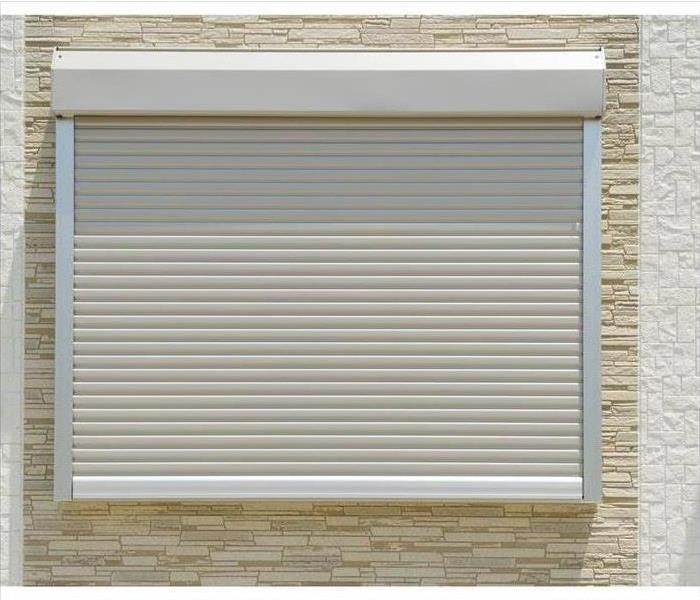 Install shutters on your windows to keep out flying debris
Install shutters on your windows to keep out flying debris
Do Not Let Hurricane Damage Destroy Your Building
You probably take steps to protect your home from hurricane damage. Yet your commercial property in Tyler, TX, could be affected by high winds and heavy rain, as well. In fact, 40 percent of small businesses that close due to hurricanes never re-open.
You thus need to secure your headquarters so you can keep the company running immediately after the storm. Here are some ways to prepare your commercial premises for a hurricane.
- Protect Key Documents
Even in this digital age, you probably still have important paper documents that are hard to reproduce. Legal contracts, accounting statements, tax returns, and insurance documents are common examples. Seal these and other similar papers in waterproof containers before the storm comes.
You should also keep the contact information for people who are most essential to your business. This could be employees, accountants, or lawyers. Put this information in an off-site location.
- Make a Checklist
Write a list of everything your employees will need if your building sustains severe hurricane damage during work hours. Gather all of those items and place them in an easily accessible location within your property.
Your storm-preparation kit should include a three-day supply of water and non-perishable food. It should also have sleeping items such as cots, pillows, blankets, and chairs. You may additionally want to store a battery-operated radio and a camera for documenting the destruction to the building.
Finally, be sure to put emergency contact information into the kit. Include the phone numbers for the Small Business Administration, your insurance provider, and a storm cleanup company.
- Protect the Premises
While restoration experts can help you rebuild your property after the storm, you should also try to protect the building as much as possible. Install shutters on your windows to keep out flying debris. Additionally, cut any trees or branches that are too close to the structure.
Do not let hurricane damage destroy your business. By preparing in advance of the storm, you can mitigate the harm.
3 Tips to Prepare for High Winds
2/1/2022 (Permalink)
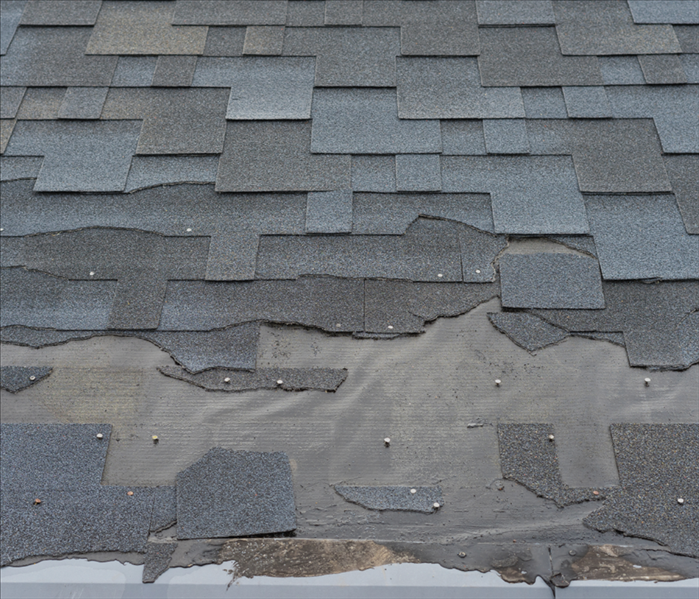 High winds can cause tiles or shingles to be loose.
High winds can cause tiles or shingles to be loose.
Prepare for High Winds
Whether from a winter storm or a summer deluge, high winds are one of the most potentially damaging parts of any storm. Able to turn simple waste bins into high-speed missiles, storm winds can be responsible for excessive property damage and even injury. If you’re wondering how to prepare your Whitehouse, TX, property for the risks of storm or hurricane damage, read on for tips that can save you money and stress.
Defining High Wind
Determining what constitutes high wind isn’t simple. The National Weather Service has tried to make it easier. Per NWS:
- Winds 15 to 25 mph are considered “breezy”
- Winds above 25 mph are considered “windy”
In general, gusts falling into the windy category warrant taking the following steps.
Secure Your Property’s Exterior
Wind can easily pick up loose items outside and launch them into a building or person. Invest in wind shutters or cover windows with plywood in a pinch if gales are anticipated. Secure items like gas tanks and water heaters to prevent them from becoming projectiles.
Secure Your Interior
It’s easy but unwise to forget about the inside of your property when preparing for hurricane damage. Anchor large furniture like bookcases and cabinets that can fall over. Use Velcro or straps to secure computers or other fragile electronics.
Inspect Your Property
One of the best tips is to inspect your property well in advance of storm season, when you have the most time to make changes. Inspect your property for trees that need trimming or removal; trees with loose root systems can easily tip over in strong gusts. Have your roof inspected to ensure there are no loose tiles or shingles that can be dislodged amid winds.
High winds can pose a high risk. Be ready. Use these tips to reduce the risk of storm or hurricane damage and contact a storm cleanup specialist to handle any damage you do incur.
What Happens During Water Heater Cleanup
1/30/2022 (Permalink)
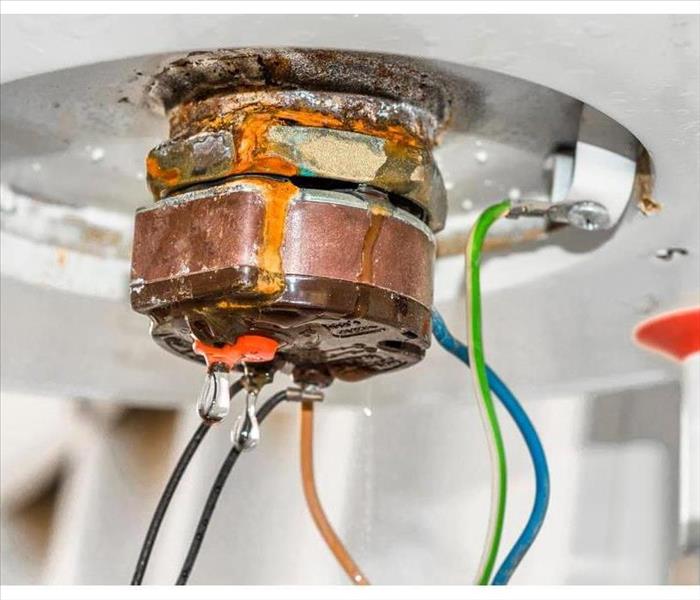 When it comes to a leaking water heater, it’s important that you never ignore it.
When it comes to a leaking water heater, it’s important that you never ignore it.
Water Heater Cleanup
Most water heaters are stored in a convenient space out of everyone’s way, either in a basement, closet or garage. While this is great when it comes to floorplan layout, it can be inconvenient if you have a leaking water heater. The time it takes to clean up after a broken water heater depends heavily on where it’s located. Here’s a look at what happens during a water heater cleanup.
1. Complication Assessment
The first thing that your water cleanup specialist is going to do is figure out how difficult of a remediation job it’s going to be. If a failed water heater has flooded part of your home, professionals will be able to figure out the easiest and best way to clear the water and restore the damage.
2. Water Extraction
The water has to be taken out quickly. Mold growth is more rampant in warm and wet areas. The warm water is perfect for the growth of bacteria. When it comes time to remove the water, you can’t simply soak it up or use a sump pump to extract it. There may be more moisture than you can see. A professional has to draw water from the walls and the carpets. This can be done with pumps, vacuums, and dehumidifiers.
3. Home Disinfection
If your leaking water heater is out of sight and out of mind, it’s possible that you won’t realize that it flooded your basement or garage. In this case, there could be time for mold to grow. Cleanup and disinfecting have to come next. Scrub walls and non-porous surfaces with a strong formula of detergent, water, and vinegar.
When it comes to a leaking water heater, it’s important that you never ignore it. While any type of flood in your Troup, TX, home can seem overwhelming, the water mitigation process is uncomplicated with the help of a remediation professional.
Two Biggest Mold Removal Costs (& Why They’re Worth It)
1/26/2022 (Permalink)
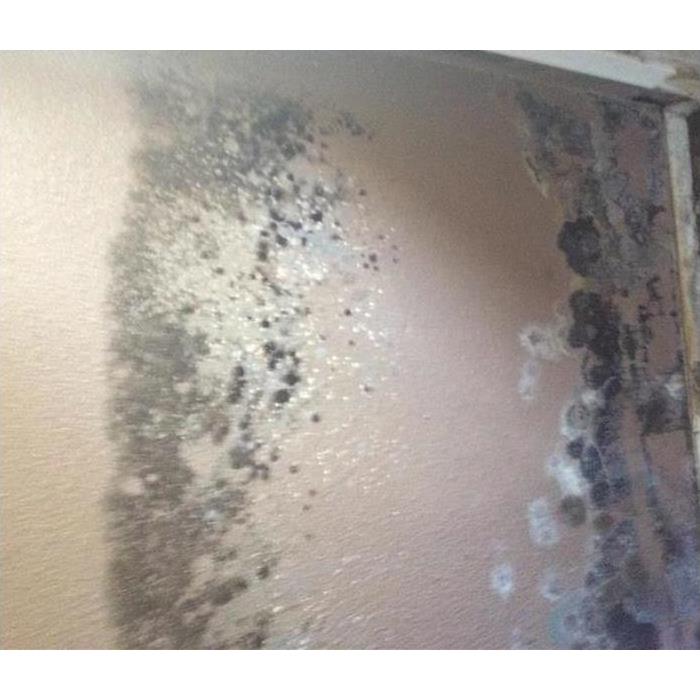 Mold found in a Whitehouse, TX home.
Mold found in a Whitehouse, TX home.
Mold is a word homeowners, renters and anyone with a property will dread. It’s associated with potential allergies and health implications, not to mention unsightly stains and smells. It also can be a big expense to remove. But why? Here are the top reasons mold removal in Whitehouse, TX can come with a big price tag.
Why Remove Mold?
Media has told us black mold removal is critical, but just why does mold need to go? There’s some controversy surrounding all the potential impacts, but a few general problems linked to mold include:
It’s worthwhile to remove it, though it is rarely cheap.
Hiring a Mold Inspector
If you think you have mold growing in your property, hiring a mold investigator is the first step to getting a handle on the problem. They will spend hours taking air samples and even opening walls to pinpoint your mold problem. Expect to spend up to $600 for a visit that will be pricey but far more accurate than any home kits you might try.
Mold Remediation
Once you’ve confirmed your mold problem, a remediation company can help remove mold and return your property to normal. In general, they’ll work to:
- Remove water-damaged materials including drywall and carpet that has been damaged beyond repair
- Dry out, disinfect and deodorize walls, carpets and furniture
- Vacuum with HEPA filters to remove lingering spores
The price for such services varies widely depending on the size of the property. Expect to spend from $500 to tens of thousands of dollars for a process that will leave your property smell and spore-free.
Mold removal can be pricey, but it is worth it in the long run. Find a reputed mold specialist to get the job done right and ensure that your mold problem is quickly a thing of the past.
How Best To Proceed With Fire Restoration
1/25/2022 (Permalink)
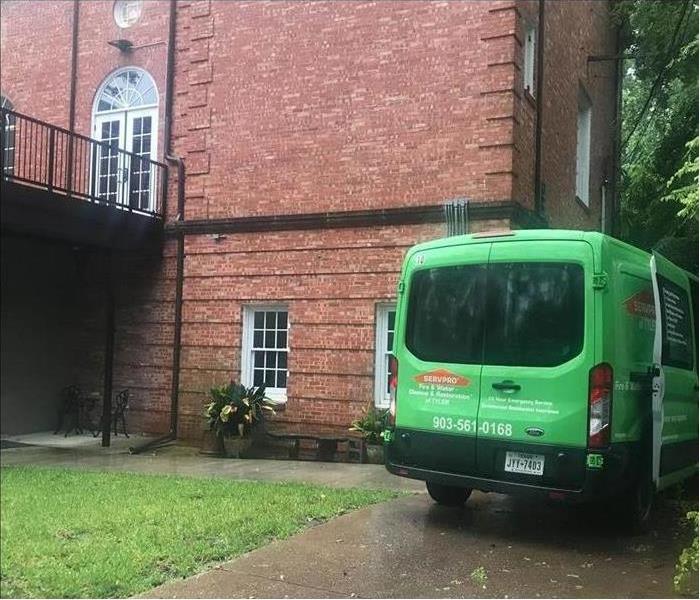 Our team provides assistance after a fire loss in your home or business.
Our team provides assistance after a fire loss in your home or business.
Fire Cleanup Process
Absorbing everything that has happened once a fire has been contained can be a lengthy process, both mentally and emotionally. Unfortunately, dealing with the fire restoration process and calling on your fire insurance is a far more time-sensitive issue. Smoke, soot and water damage in commercial buildings in Tyler, TX, should be addressed quickly, as the effects can be detrimental to everyone’s health and safety. Learn how to start and manage the fire cleanup process with these important tips, and get help to begin the difficult task of smoke cleaning from the affected areas.
? Consult professionals before taking any first steps yourself. The charred and damaged areas consumed by the fire can be highly dangerous, whether due to unstable structures or dirty water and soot left behind that could potentially make you sick. Waiting for the fire department to give the all-clear signal before entering the building is crucial.
? Get estimates regarding restoration and cleaning fees. Fire restoration can come with an expensive price tag, depending on the significance of the repairs needed. Initiate the steps necessary to determine what your insurance company will cover, and be sure to keep all agreements in writing to cover yourself legally.
? Start hiring fire repair and board-up services — and keep any receipts related to the fire damage. Professional cleaners are vital to the restoration process to ensure the area is safe for people to inhabit again, while board-up providers can keep company belongings secured while you’re away. Meanwhile, it’s important to keep all receipts in a safe place for your personal records and to have copies handy for your insurance company, as well as for tax purposes.
Clearing away smoke damage through fire restoration procedures is essential to the health and safety of everyone involved. Take the necessary time to contact your fire insurance representatives and invest in proper smoke cleaning for the sake of all who were affected by the tragedy.



 24/7 Emergency Service
24/7 Emergency Service




























